While Staying at Home More, Our Interest in Bird Watching Takes Flight
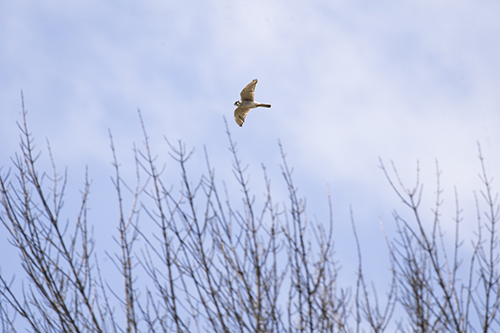
Our Nature Initiative installed nesting boxes for the American Kestrel, which helped bring back the smallest falcon to Grace Farms. The kestrel was listed as threatened on Connecticut’s Endangered, Threatened, and Special Concern Species List. It was down-listed to special concern in 2015. © Julien Jarry
Our enthusiasm for birdwatching has taken off during the COVID-19 pandemic. Cornell’s Lab of Ornithology in Ithaca, New York, reports that visits to their live bird cams have doubled since the pandemic. Sales of “birding” merchandise, including birdseed, also increased upwards of 15 percent this year, according to the Associated Press.
The pause we’ve taken during COVID, has allow us to explore birds – what birds eat, where they thrive, and their migration patterns. In the process, we’ve reconnected to nature and the joy in discovering the natural world. This summer offers an abundance of opportunity to explore their sphere in our local communities – from urban to rural environments. (The featured photo, above, is a male Eastern Bluebird, which can be found in meadows and openings surrounded by trees that offer protective nesting spots.)
Our master birder, Frank Mantlik – who has mastered the techniques to identify birds by sight, sound, local ecology, and habitat – will take us on a virtual birdwatching journey along Grace Farms’ 80-acre preserve and throughout Connecticut in conversation with Mark Fowler, former Nature Initiative Director. We’ve restored more than 10 different habitats, including open meadows, woodlands, wetlands, and mix hardwood forests, bringing back a variety of wildlife, including more than 100 species of birds.

Our Cattail Pond and the surrounding habitat is a vital source of shelter and food for wildlife at Grace Farms © Sharon Prince
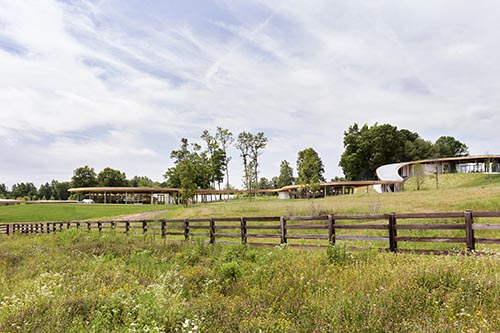
Biodiverse habitats surround the River building which was designed by award-winning architectural firm SANAA. Its more than 200 windows eliminates the barrier between nature and architecture. © Dean Kaufman
All you really need to start is curiosity. While binoculars can help with close-ups of birds, the resources we’ve included below will provide a launch into the unique world of birds and their habitats. Some birds are shy like the Barred Owl and will be easier to identify through their sounds. Listen for the Barred Owl’s hoot during the evening hours.
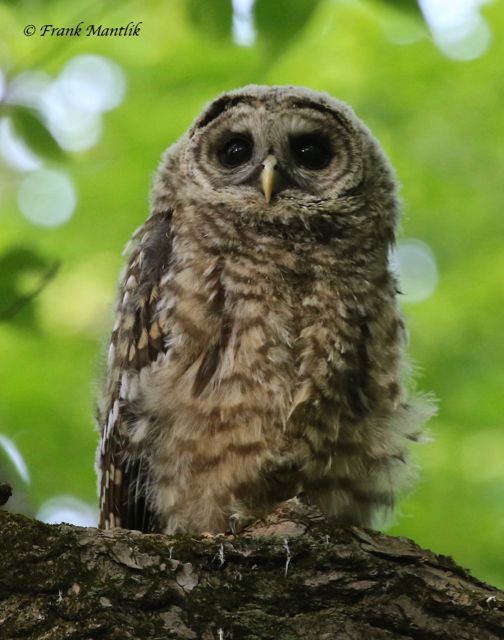
Here is a young Barred Owl, which usually hides quietly in forest trees during the day. We spotted one last year at Grace Farms during the winter months. According to the Cornell Lab, the Barred Owl doesn’t move around much, so if you live near a wooded area you’ll likely hear the Barred Owl before you see one.
Q&A
Mark Fowler: There’s been an explosion of birdwatching since the pandemic. Uploads of photos and bird calls from Cornell’s crowdsourced bird-logging app, eBird, have increased 45 percent and 84 percent, respectively. Of all the things we can do with our time, why is birdwatching the fastest growing outdoor activity?
Frank Mantlik: In everyone’s busy work-life, we need a way to relax or unwind…often by going outdoors. The pandemic gave us an opportunity to stop and observe nature. Various nature and Audubon centers, bird clubs, and of course Grace Farms, offer a wide selection of bird walks. It can have a great social aspect as well. Since most people have cameras on their phones, a lot of people are discovering birds as subjects. There are also many resources for people to research birds to help with identification, including printed and digital field guides. There are numerous apps, as well, such as Merlin and iNaturalist, that can help quickly identify species. (Some public spaces may still be closed, so check before you visit. Grace Farms is closed for an indeterminate period.)
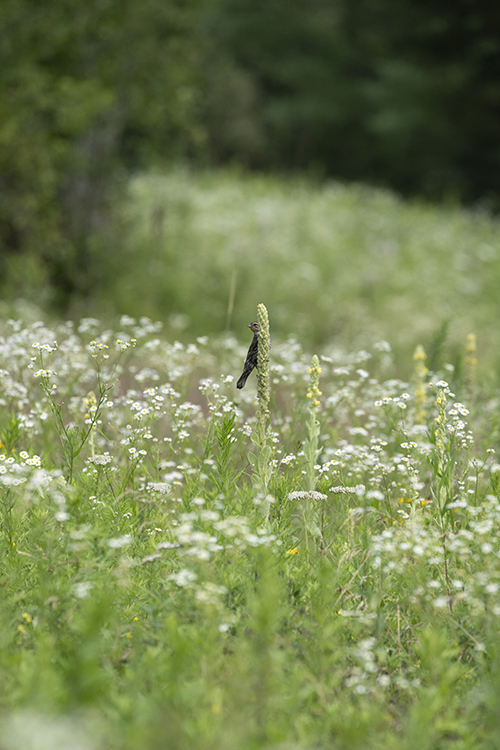
Grace Farms provides shelter and food for birds and other wildlife. © Julien Jarry
MF: With the help of free bird identification apps, what birds should we be looking for during the summer?
FM: Each season has its particular types of bird species that are more prevalent. Some bird species, such as woodpeckers and cardinals, live here year round. During spring, many species of songbirds, herons, waterbirds, shorebirds, and hawks return to Connecticut from their wintering grounds to the south and so these are some of the birds we can discover now. Some pass through to nesting areas farther north into Canada, but many will stop to nest in our local area. There are about 160 bird species that nest in the state throughout summer.
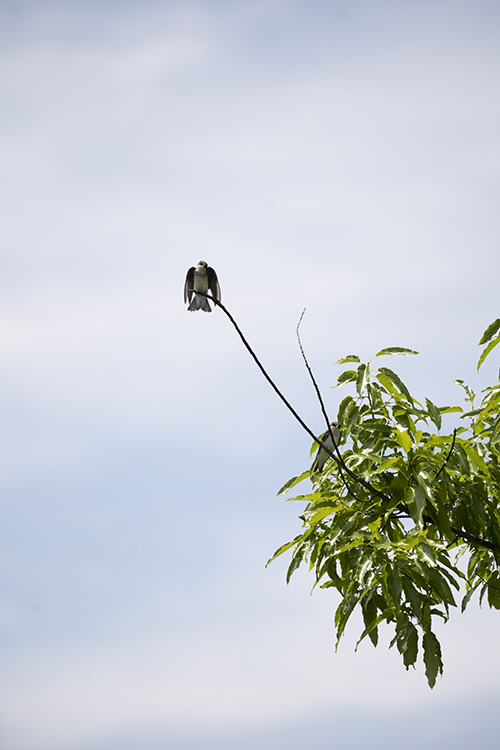
Birds of prey such as the Red-tailed hawk and the American Kestrel can be spotted at Grace Farms. © Julien Jarry
Common birds to look for include: Canada Goose, Mallard, Wild Turkey, Mourning Dove, Ruby-throated Hummingbird, Killdeer, Common Tern, Green Heron, Snowy and Great Egrets, Osprey, Red-tailed and Red-shouldered Hawks, Barred Owl, Downy and Red-bellied Woodpeckers, Eastern Phoebe, Blue Jay, American Crow, Barn Swallow, Black-capped Chickadee, Carolina Wren, American Robin, House Finch, Yellow Warbler, Song Sparrow, Northern Cardinal, Red-winged Blackbird, and the Baltimore Oriole.
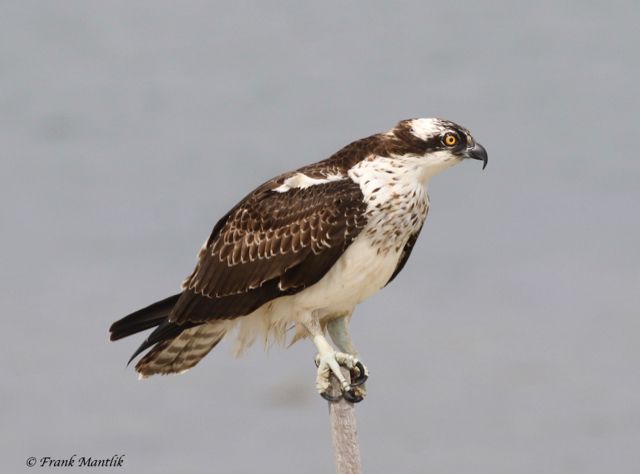
The Osprey is part of the hawk family. They can be found near any body of water such as saltmarshes, rivers, ponds, reservoirs, and estuaries. Their nests are easy to find: they are made of sticks and are often in plain sight such as on top of poles.
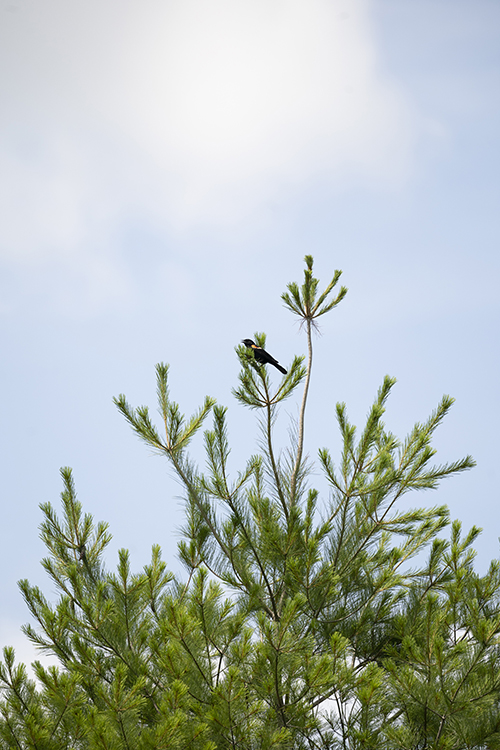
The Red-winged Blackbird can be found in open habitats, such as fields, mudflats, farm fields, and pastures. Here is one perched on a tree at Grace Farms. © Julien Jarry
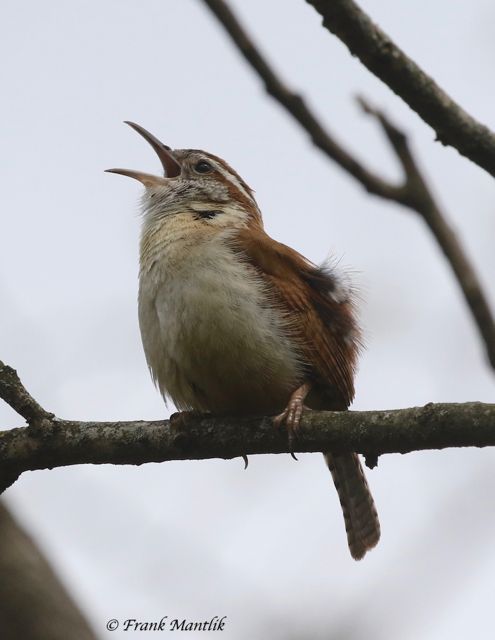
The Carolina Wren often holds its tail down when singing. Wrens defend their territories with constant singing; they aggressively chase off intruders. You may see the wren running up and down a tree trunk in search of food – insects and fruit. Only male Carolina Wrens sing.
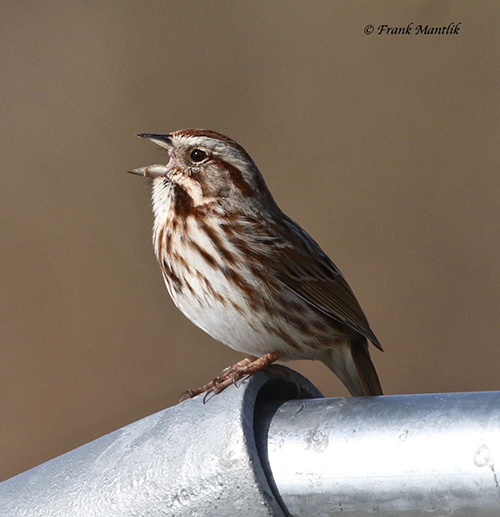
The Song Sparrow is so common in urban and rural environments we tend to overlook these tiny, scrappy birds. They fly in short and fluttering bursts. They can be found in open habitats, including marsh edges, overgrown fields, backyards, and city landscapes. Listen to their songs.
MF: Of the birds you just mentioned, what are some of the birds you’ve seen at Grace Farms?
FM: I have seen all those species with the exception of Common Tern and Snowy Egret, which are both mainly coastal. To see a list of all the species (101) that have been recorded at Grace Farms since 2017, click on this eBird link.
MF: Are there any rare or unique species that you search for and are excited to see during this time of year?
FM: Yes. Many species nest in particular habitats, so to find them you have to visit those places. These include Piping Plovers and Least Terns on sandy beaches, Peregrine Falcons on a rock cliff or a tall building, Saltmarsh and Seaside Sparrows in a large salt marsh, Virginia Rails and Least Bitterns in a freshwater marsh, and Bobolinks in a large grassy meadow.
MF: You recently spotted the elusive Townsend’s Warbler around the Hartford area in April, which no birder in Connecticut has spotted until now, putting the number of birds you’ve seen to 400 since you started birdwatching in 1972. I understand that’s a huge accomplishment among birders. What are some tips to help newcomers to birdwatching?
Here are a few tips. To attract birds to your yard for close viewing, put up some bird feeders and a water bath. Most people feed birds just during the colder months, but many also feed year-round. Contact The Connecticut Audubon Society, The National Audubon Society, or a local private bird supply store such as The Fat Robin or The Wild Bird Store.
Like anything, it’s always easiest to learn from those who are experienced. I highly recommend joining the Connecticut Ornithological Association, which offers many bird-walks and workshops, a listing of state-wide events, and a list-serve which reports many daily bird sightings. If you can, purchase binoculars and a bird field guide, which will help with identification.
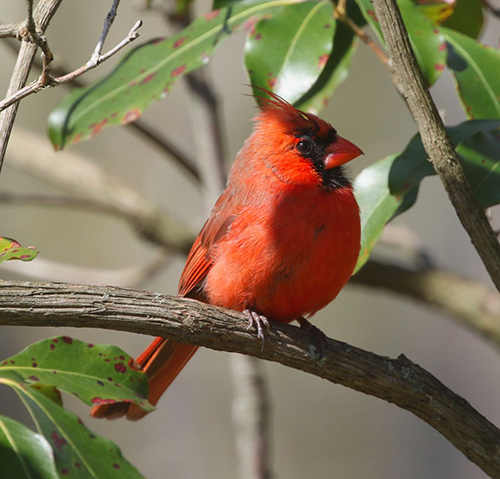
The male Northern Cardinal is perhaps one common bird in this area that is easy to identify given its flashy red coloring. Cardinals tend to forage on or near the ground and are often in pairs. The female Cardinal’s coloring is a warm brown and the tips of her wings and tail are a soft red.
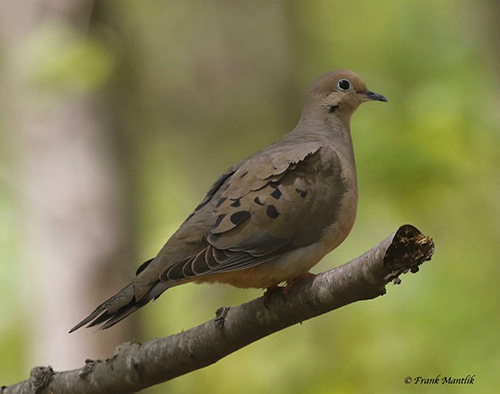
Like the owl’s hoots, the Mourning Dove has a distinct sound. They are common birds in North America and can easily be found on the ground looking for food. While bird feeders will attract doves, it makes them an easy target for cats.
MF: Being mindful of social distancing, what are some of the things we can do to enjoy birding on walking trails or from our own homes and yards? Are there any special bird watching areas in our region that you recommend?
FM: What’s nice about birdwatching is that it can be done alone or with others – family, neighbors, or friends – (socially-distant and wearing masks), any time of day, and just about anywhere. It’s easy to enjoy birds in one’s own yard, particularly if you have trees and shrubs. You can easily attract more birds to your yard by installing bird feeders and/or a water bath.
During this pandemic, I birded often at a small local forested town park (with pond) that is only about a mile from my house [in Stratford]. I tallied over 80 species seen there this spring, including 20 species of colorful warblers, and some of them uncommon, such as an Olive-sided Flycatcher.
There are quite a few sites all around Connecticut that have become popular among birders because they are home to a wide variety of species. We call these places “hotspots”. A small sampling includes: Greenwich Point Park (Greenwich), Sherwood Island State Park (Westport), White Memorial Foundation (Litchfield), McKinney National Wildlife Refuge (Stratford, Westbrook), East Rock Park (New Haven/Hamden), River Road (Kent), Cedar Hill Cemetery (Hartford), Hammonasset Beach State Park (Madison), Barn Island Wildlife Management Area (Stonington), and Bafflin Sanctuary (Pomfret).
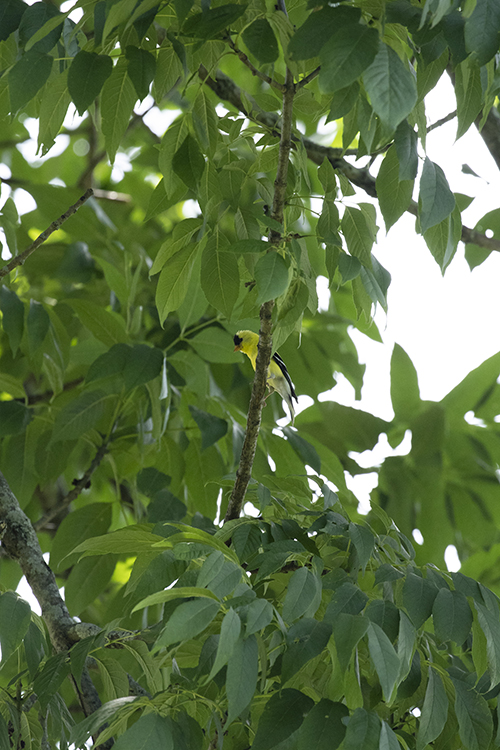
The American goldfinch molts durning the winter months to reveal duller, drab colors, which allows the finch to blend into the stark winter environment. © Julien Jarry
Two books are indispensable as site guides: “Birding in Connecticut” by Frank Gallo (2018, Wesleyan University Press), and “Connecticut Birding Guide” by Buzz Devine and Dwight Smith (1996, Thompson-Shore). Other hotspots can be explored on the internet via eBird.
MF: You mentioned we can birdwatch any time of day, any times in particular we are more likely to spot birds and where?
FM: Generally there is more songbird activity early in the morning, before the heat of the day quiets them down. It’s easy to visit your “local patch,” a local park or pond, in search of birds. Besides looking for them visually, listen for their vocalizations and track them down to see them.
MF: Since Connecticut and New England have diverse ecosystems such as coastlines, wetlands, ridges, and mountains, how are bird species fairing and how do birds benefit from the biodiversity of our region?
FM: Overall, our bird biodiversity is remaining fairly stable. But some habitats are in decline, as are the species reliant on them. Among one of the most endangered ecosystems in our region is grasslands. Since colonial times, forests have reclaimed many former cleared, grassy farms and meadows. So, species such as Upland Sandpiper, Grasshopper and Vesper Sparrows, and Eastern Meadowlarks are in population decline.
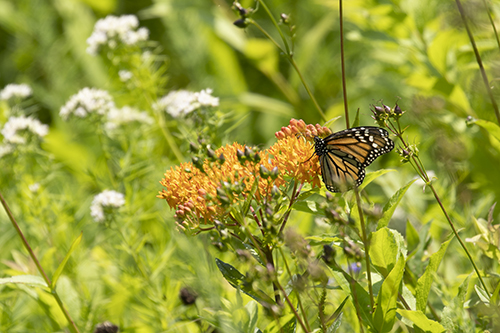
The restoration of Grace Farms’ 80 acres, including the installation of thousands of native plants, has not only brought back a variety of birds, but other important pollinators, including bees and butterflies. Using native plants to restore bio-diversity is a nature-based solution used at Grace Farms. © Julien Jarry
Oddly, many species such as thrushes and warblers, that require large tracts of forest, are also in decline. Among the reasons are fragmentation of the forest due to human development, loss of their wintering habitat in Central and South America, more severe storms during migration due to climate change, etc.
It’s not all bad, as species whose populations are rising include: Wild Turkey, Bald Eagle, Osprey, Double-crested Cormorant, and Common Raven.
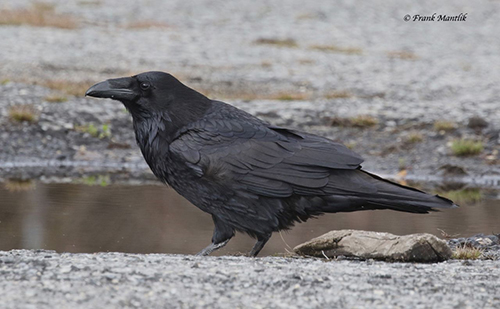
The Common Raven intrigued poet Edgar Allan Poe so much he wrote a poem called “The Raven.” Besides inspiring poets, the raven inspires scientists to create problems for “the smartest of all birds” to solve. Listen to the raven’s distinct voice.
MF: When the Townsend’s Warbler is officially accepted by the Connecticut Ornithological Association, it will be the 446th species recorded in the state. So, there are plenty of birds to discover. If you had to give us a challenge, what bird should be on our list to find in Fairfield County or in the state?
FM: Yes, that is an amazing cumulative list of birds for such a small state as Connecticut. Any future new discoveries are sure to be extremely rare here. But some species to be on the lookout for include Neotropic Cormorant, Allen’s Hummingbird, Common Ringed Plover, Vermilion Flycatcher, Black-throated Sparrow, and Swainson’s Warbler. Each of these have occurred in nearby states, and I dream about finding any one of them.
MF: Thanks for taking the time to talk with us today, Frank. Birds are such incredible creatures and an essential part of the web of life necessary to maintain biodiversity and healthy ecosystems in our region and around the world. Are there any resources you can recommend to help people identify birds?
FM: There are a number of excellent printed field guides to birds. Among the best for our region are:
- The Sibley Field Guide to Birds of Eastern North America (2nd Edition)
- The Sibley Guide to Birds (2nd Edition)
- Peterson Field Guide to Birds of North America (2nd Edition)
- National Geographic Field Guide to the Birds of North America (7th Edition).
Several of these might be available as an app for your smartphone as well.
As mentioned earlier, online and digital resources include:

